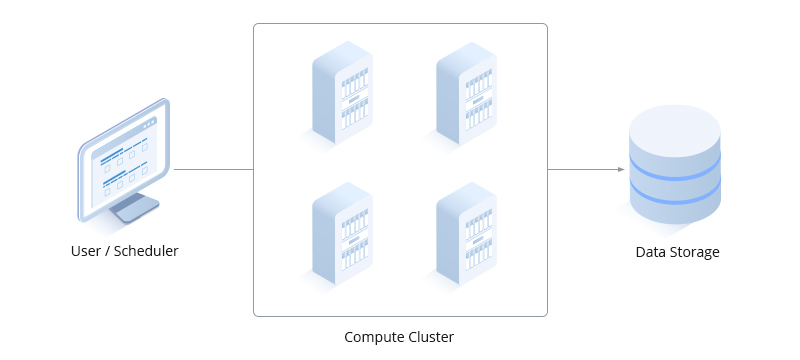What Is High-Performance Computing (HPC)?
As technology evolves and finds applications in advanced fields such as engineering, medicine, finance, space exploration, etc., there’s an upsurge in demand for highly efficient, reliable, and robust computer systems capable of performing more with less. Processing speed, storage, and networking capabilities are the critical aspects of computing solutions, and that’s where high-performance computing (HPC) comes in.
What Is High-Performance Computing?
High-Performance Computing is the practice of combining computing power to deliver much more performance than a typical computer. This is achieved using parallel data processing systems where several servers work together to complete a task.
HPC increases the computing performance, giving complex calculations and advanced applications a smooth run. For instance, a 3GHz processor in a typical laptop can perform up to 3 billion calculations in a second. But, an HPC can perform quadrillions of calculations in a second. That’s how fast an HPC can operate, a great example being the supercomputer.
The high-performance computing system was developed to meet the rising demand for faster, reliable, and scalable compute speeds. Modern HPCs bring together algorithms, computer architecture, system software, specialty programs and apps, advanced sensors, etc. These systems find applications in high-performance environments where speed, accuracy, and reliability are given priority.
Characteristics of High-Performance Computing
The three main components of an HPC system are compute, storage and network. The compute components comprise parts such as the motherboard, RAM, CPU, hard drive, etc., needed to complete specific tasks such as running computations and critical software. Networking components ensure the system and the users are well connected, allowing access to critical resources like remote computers and the Internet. Storage components hold the recorded data and ensure they are easily accessible whenever needed.
In an HPC, multiple computer servers are networked to form a cluster, which serves as an efficient HPC architecture system. The servers in the cluster are concurrently run with algorithms and software programs to complete different tasks. And to store or access required information, the cluster is networked to data storage systems.

Each component of the high-performance computing infrastructure must keep pace with each other to ensure maximum performance. All networking systems should also have the capacity to support the high-speed data transmission between the computing servers and data storage.
Other distinctive features of the high-performance computing system are:
-
Powerful search – HPCs have powerful search capabilities that allow users to easily navigate between files, applications, and huge databases. This makes regular interaction with the computer quite convenient.
-
Advanced directory browsing – the HPC has advanced mechanisms that allow for traversing directory standards. This gives users the option to cache directory lists from distributed hosts, enabling fast re-display of previously visited directories.
-
Authentication management – to make system authentication and access a breeze, HPCs allow trusted connections to be cached and re-used. This means authentication information can be stored during a session and re-used the next time you want to use the system.
-
Drag and drop file transfer – this allows for faster transfer of files and enhances the user experience, especially when dealing with huge data sets.
-
Directory synchronization – HPC allows for synchronizing remote or local directories, where old files (in the destination folder) can be replaced by newer ones in the source file/folder.
Why is High-performance Computing Important?
HPC has played a significant role in the research and innovation worlds for decades. Engineers, designers, scientists, and other professionals have leveraged the power of HPC to make significant breakthroughs. Below are the primary benefits of HPCs.
High Speed
HPCs are designed for fast-speed processing. This translates to HPC systems performing massive calculations in seconds that would have taken weeks or months using regular processors.
Reduced Cost
Since HPC systems have a high processing speed, applications run faster, and therefore answers to complex calculations are yielded quickly. Fast calculations translate to less money and time spent on tasks. In addition, startups and small businesses can afford to run HPC workloads using cloud-based HPC since they only have to pay for what they use and can scale up when and where needed.
Reduced Physical Testing
Most modern-day applications require physical testing before being used in the market. HPC systems can create simulations, thus eliminating the need for physical tests, which can be costly and prone to errors.
Getting Started with HPC
High-performance computing marks a new era of innovation, where digital computing is poised to solve big problems that affect humanity. It’s just a matter of time before HPCs go mainstream to unlock the imminent power locked within our day-to-day processes. If you are interested in adopting HPC systems, begin by evaluating the areas that could benefit from enhanced computing, networking, and storage capabilities.
Related Articles:
How to Achieve Low-Latency Networks for High-Performance Computing?
InfiniBand Insights: Powering High-Performance Computing in the Digital Age
You might be interested in
Email Address

-
PoE vs PoE+ vs PoE++ Switch: How to Choose?
May 30, 2024















